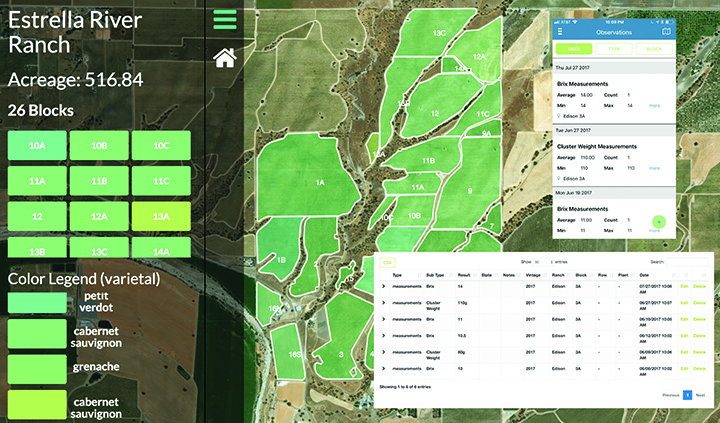When Cyrille Habis and Prasad Nair embarked on their journey into agricultural technology, they did not envision that their end product would be a revolutionary data imagery package that could forecast yields weeks to months in advance. After all, the two specialized in building robots.
“We initially wanted to build a drone or robotics company, but one farmer changed that for us,” said Habis, co-founder and CEO of AgriData. In October 2015, when the duo was first looking for a product to build their business around, they attended a tech conference where they met a large-scale apple grower who was looking for a crop estimation solution. The grower was asking all the drone companies if their solution would estimate how much yield his apple orchard would produce that season. No one did.
“We listened to his questions and started talking to him to learn more about what his needs were,” said Habis. “After that initial conversation, we were finding that a lot of growers were facing the same type of issue. Crop estimates that were too low or too high both had a significant financial downside to farming businesses. It was a problem worth solving so we went for it and never looked back.”
They launched AgriData at the end of 2015. AgriData has built a system that translates crop data from orchards and vineyards into accurate prediction models that allow growers to see what is in the field now and what will be available later. The start-up company takes the camera that is typically used on drones and mounts it on ground vehicles to collect and calibrate data that allows growers to forecast crops up to three month prior to harvest. This data also helps farmers evaluate attributes such as maturity, defects, diseases and pests.
The idea behind placing cameras on vehicles such as tractors and loaders comes down to cost savings and accuracy. AgriData wanted a solution that would not add to owners’ labor costs, while simultaneously collecting data. Additionally, the team wanted to eliminate the added costs that typically come with drones, such as hiring a drone operator or spending time, money and resources on employees to become certified to operate a drone.
“If you are flying something, you can’t really tell what’s going on. We wanted more imagery precision and knew that having the camera on the ground would provide more accuracy,” said Habis.
A light bulb went off for Habis and Nair. They realized that data could be collected while doing everyday activities on the farm, such as applying crop protectants or checking on the crop. AgriData altered the camera to be able to mount to any existing farming vehicle, resulting in no extra labor or equipment cost.
DEPLOYMENT TO RESULTS
When working with a customer, AgriData visits the operation to identify the vehicles on which the camera would be most effective. The startup then imports a map of the ranch into its comprehensive software solution. To start, companies can survey anywhere from 50 to 300 acres. Once customers are comfortable with using the technology, the amount of acreage estimated can be expanded. AgriData then sets up team members with the web portal and mobile app and ensures that they are trained to access and assess the easy-to-understand data.
According to AgriData, growers will earn 25 to 30 percent more in sales if they are able to estimate their crops properly. “What if you don’t know how much produce you have? It would hurt profits, be a logistical nightmare and you’re taking major business risk every time you sell in advance,” said Habis.
AgriData believes that by estimating yields, potentially identifying diseases in the field and tracking inputs three months out, growers can exact the following benefits:
• Cost Savings: Owners will know how fruitful a crop will be, dictating how much labor is needed to harvest that block ahead of time. Growers will also avoid having to sell the produce at a loss or spend money on storage, in the event that more fruit is grown than expected.
• Strengthen Brand Reputation: Grower-shippers can deliver what they promised to retailers 100 percent of the time.
• More Efficient Operations: Owners can maximize revenue by remedying low-yield areas and make quantity/quality tradeoffs by managing their crop load with precision.
• Accurately Manage Resources: Users can select customized qualitative attributes—such as maturity, defects, diseases and pests—for inclusion in field scans to better allocate resources.
“With our product, you are able to look at environmental conditions and optimize farming in a way that you couldn’t do before,” said Habis. “We are proud of the fact that we honed in on a specific issue growers were facing and built a solution to fix that exact problem. It’s a high-impact solution that has an extremely high ROI [return on investment].”
FOUNDATION TO FUTURE
Currently, AgriData specializes in orchards, vineyards and bushes—crops including citrus, grapes, berries, and stone fruit. The firm hopes to expand the number of crops served within the next two to three years. Through partners like Western Growers and its Center for Innovation & Technology, AgriData is becoming integrated with growers of all types of specialty crops, learning how to optimize their product to fit the needs of the industry as a whole.
“The exposure, connections and network to the Western Growers’ audience has been invaluable,” said Habis. “The staff at the center has been great at making introductions with our potential customers, when appropriate. Many of these introductions have led to direct engagement and pilots.”
For more information about AgriData, contact Cyrille Habis at (650) 353-1829 or [email protected].




